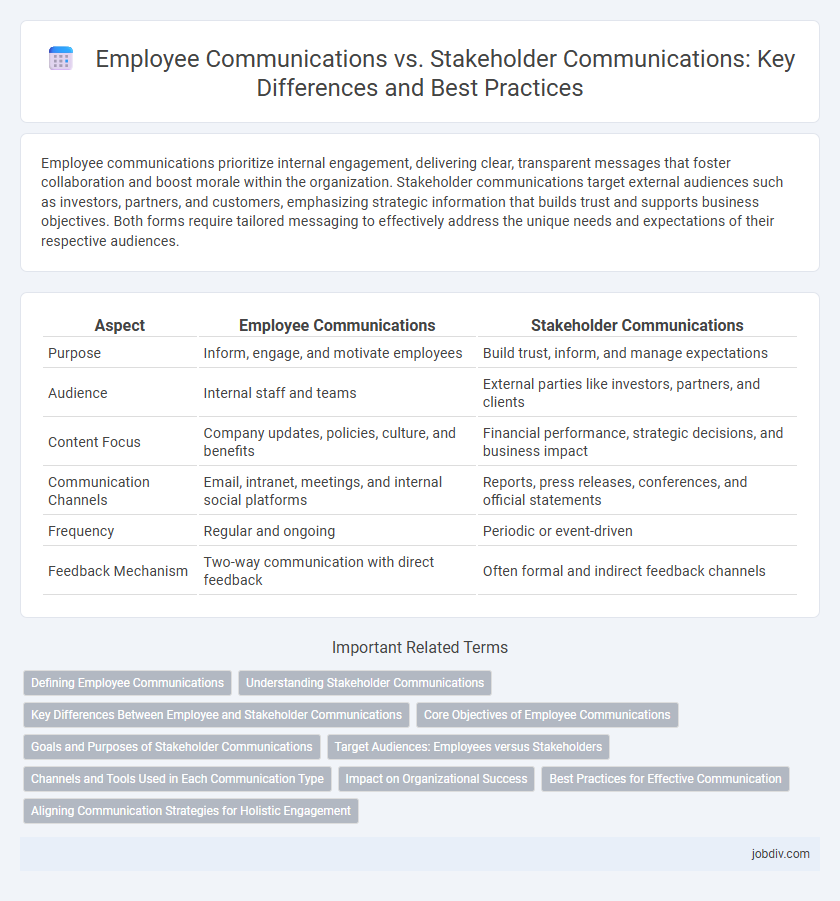Employee communications prioritize internal engagement, delivering clear, transparent messages that foster collaboration and boost morale within the organization. Stakeholder communications target external audiences such as investors, partners, and customers, emphasizing strategic information that builds trust and supports business objectives. Both forms require tailored messaging to effectively address the unique needs and expectations of their respective audiences.
Table of Comparison
| Aspect | Employee Communications | Stakeholder Communications |
|---|---|---|
| Purpose | Inform, engage, and motivate employees | Build trust, inform, and manage expectations |
| Audience | Internal staff and teams | External parties like investors, partners, and clients |
| Content Focus | Company updates, policies, culture, and benefits | Financial performance, strategic decisions, and business impact |
| Communication Channels | Email, intranet, meetings, and internal social platforms | Reports, press releases, conferences, and official statements |
| Frequency | Regular and ongoing | Periodic or event-driven |
| Feedback Mechanism | Two-way communication with direct feedback | Often formal and indirect feedback channels |
Defining Employee Communications
Employee communications refer to the strategic dissemination of information within an organization to engage, inform, and motivate employees. It encompasses internal messaging channels such as emails, intranets, newsletters, and team meetings tailored to enhance workforce alignment and productivity. Effective employee communications foster transparency, build organizational culture, and support change management initiatives by ensuring employees receive timely and relevant information.
Understanding Stakeholder Communications
Stakeholder communications involve conveying targeted information to individuals or groups who have a vested interest in the organization's success, such as investors, partners, and regulatory bodies. Unlike employee communications that focus primarily on internal workforce engagement, stakeholder communications require a nuanced approach addressing diverse expectations, strategic goals, and external impacts. Effective stakeholder communication leverages clear messaging, transparency, and feedback mechanisms to foster trust, alignment, and long-term collaboration.
Key Differences Between Employee and Stakeholder Communications
Employee communications focus on internal messaging aimed at workforce engagement, clarity in job roles, and fostering organizational culture, while stakeholder communications address external or broader audiences, emphasizing transparency, trust-building, and corporate reputation. Employee communications typically utilize direct channels like intranets, newsletters, and team meetings, whereas stakeholder communications rely on reports, press releases, and investor briefings. The key difference lies in content specificity and audience targeting: employee messaging centers on operational details and motivation, while stakeholder communication prioritizes strategic objectives and accountability.
Core Objectives of Employee Communications
Employee communications primarily aim to enhance internal engagement, improve productivity, and foster a positive organizational culture by ensuring clear, consistent messaging tailored to employees' needs. These communications focus on delivering timely updates, facilitating feedback channels, and promoting alignment with company values and goals. Effective employee communication drives motivation, supports change management, and strengthens overall workforce collaboration.
Goals and Purposes of Stakeholder Communications
Stakeholder communications aim to build trust, foster transparency, and align diverse interests to support organizational success. Key goals include informing stakeholders about company performance, managing expectations, and encouraging engagement in strategic initiatives. Unlike employee communications, which focus on internal updates and motivation, stakeholder communications prioritize external relationships and long-term value creation.
Target Audiences: Employees versus Stakeholders
Employee communications target internal audiences such as staff members and management, focusing on engagement, culture, and operational updates to enhance productivity. Stakeholder communications address external or broader groups, including investors, clients, regulators, and community members, emphasizing transparency, brand reputation, and strategic objectives. Tailoring messages according to these distinct audiences ensures clarity, relevance, and strengthened organizational relationships.
Channels and Tools Used in Each Communication Type
Employee communications primarily utilize internal channels such as intranets, email newsletters, collaboration platforms like Microsoft Teams or Slack, and town hall meetings to ensure consistent and direct information flow within the organization. Stakeholder communications, on the other hand, often rely on external-facing tools including press releases, corporate websites, social media platforms, investor relations portals, and formal reports to engage shareholders, customers, and partners effectively. Leveraging the appropriate channels tailored to each audience enhances message clarity, engagement, and stakeholder trust across both communication types.
Impact on Organizational Success
Employee communications directly influence organizational culture, engagement, and productivity by fostering transparency and trust within the workforce. Stakeholder communications broaden the impact by aligning external partners, investors, and customers with the company's vision, enhancing reputation and long-term sustainability. Effective integration of both communication streams is critical for driving overall organizational success and resilience.
Best Practices for Effective Communication
Employee communications prioritize clarity, consistency, and timely updates to foster engagement and alignment within the organization. Stakeholder communications emphasize transparency, relevance, and responsiveness to build trust and support diverse external audiences. Tailoring messages to the audience's needs and leveraging appropriate channels enhance overall communication effectiveness.
Aligning Communication Strategies for Holistic Engagement
Employee communications focus on internal messaging to foster engagement, motivation, and productivity among staff, while stakeholder communications target external parties such as investors, customers, and partners to build trust and support. Aligning communication strategies ensures consistent messaging, reinforces organizational values, and enhances collaboration across all levels of the business. Integrating these approaches leads to a holistic engagement framework that drives transparent dialogue and strengthens overall brand reputation.
Employee Communications vs Stakeholder Communications Infographic

 jobdiv.com
jobdiv.com